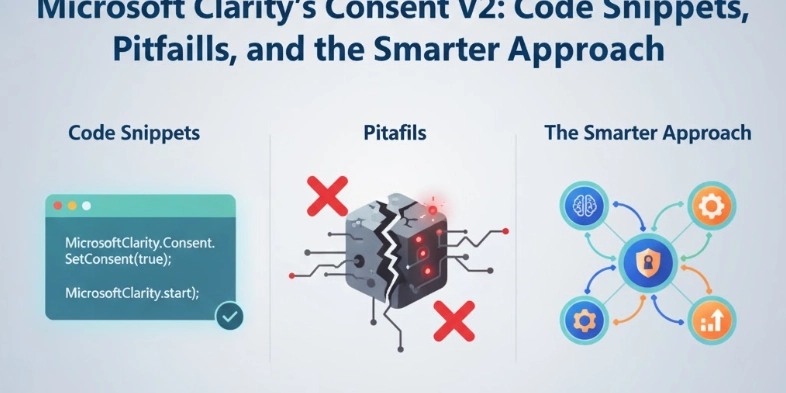Developers, let’s talk about why you need to implement Consent API V2 for Microsoft Clarity before October 31st, 2025.
If you’re running Clarity without consent signals, your analytics are technically non-compliant in the EEA, UK, and Switzerland. Microsoft is enforcing this. The tracking stops November 1st unless you’re set up properly.
The Core Implementation
Consent API V2 works through a simple window command. You send consent signals for two storage types: ad_storage and analytics_storage.
Here’s the basic structure:
window.clarity('consentv2', {
ad_storage: "granted",
analytics_storage: "granted"
});
This tells Clarity: the user approved both types. Clarity starts tracking normally.
For denied consent:
window.clarity('consentv2', {
ad_storage: "denied",
analytics_storage: "denied"
});
Clarity enters limited mode. No data collection happens.
For mixed scenarios:
window.clarity('consentv2', {
ad_storage: "granted",
analytics_storage: "denied"
});
This grants ad tracking but denies analytics. The user controls the granularity.
The Implementation Workflow
- User visits your site
- Your consent banner (CMP) appears
- User makes a choice
- Your CMP captures the decision
- Your code sends the signal to Clarity
- Clarity respects the choice
The critical step: the signal must fire before Clarity’s tracking script fully loads. Timing matters.
Common Pitfalls Developers Hit
Pitfall #1: Sending Signals Too Late
If you fire the consent signal after Clarity starts tracking, you’ve already collected unauthorized data. The signal must come first. Load your CMP before Clarity’s tracking script.
Pitfall #2: Forgetting to Specify Both Storage Types
You must explicitly declare both ad_storage and analytics_storage. If you only specify one, Clarity won’t know what to do with the other. Always be explicit.
Pitfall #3: Assuming Default Behavior
Don’t assume Clarity defaults to “denied” if you don’t send a signal. It might attempt tracking anyway. Always send explicit signals. No assumptions.
Pitfall #4: Testing Only in Your Region
Test with users in the EEA, UK, and Switzerland if possible. Their stricter GDPR rules will catch implementation errors that other regions might miss.
Pitfall #5: Not Testing Consent Updates
Users might change their minds. Your code must handle consent updates dynamically. Send new signals when preferences change.
The Manual vs. Automated Dilemma
Manually implementing this means:
- Building a consent banner
- Managing user preferences in your database
- Writing code to send signals to Clarity
- Maintaining this as regulations change
- Testing across browsers and regions
- Handling consent updates
It works, but it’s time-consuming. You’re essentially building a consent management platform from scratch.
The Smarter Approach
A dedicated consent management platform handles this automatically. It manages consent capture, stores preferences, sends signals to Clarity, and updates when regulations change. You focus on development. The platform handles compliance.
Platforms like SeersAI do exactly this. They integrate with Clarity’s Consent API V2 automatically. You enable it in their dashboard. The signals fire correctly, timing is perfect, and storage is compliant. No custom code needed.
The platform also handles edge cases you might miss: expired consent, regional variations, consent withdrawal, and preference updates.
Performance Considerations
If you’re building manual consent signal handling, keep it lightweight. Large consent banner scripts can slow page load. Defer non-critical consent collection logic.
Event-driven signals are better than polling. Listen for user actions (button clicks on your consent banner), then fire signals immediately.
Moving Forward
If you’ve already implemented Consent API V2 manually, test thoroughly. If you haven’t, decide: build it yourself or let a specialized platform handle it.
Either way, October 31st is here. Test your implementation now. Don’t wait until November when Clarity enforcement kicks in.
See how SeersAI automates Clarity compliance
Compliance isn’t optional. Make it automatic.



